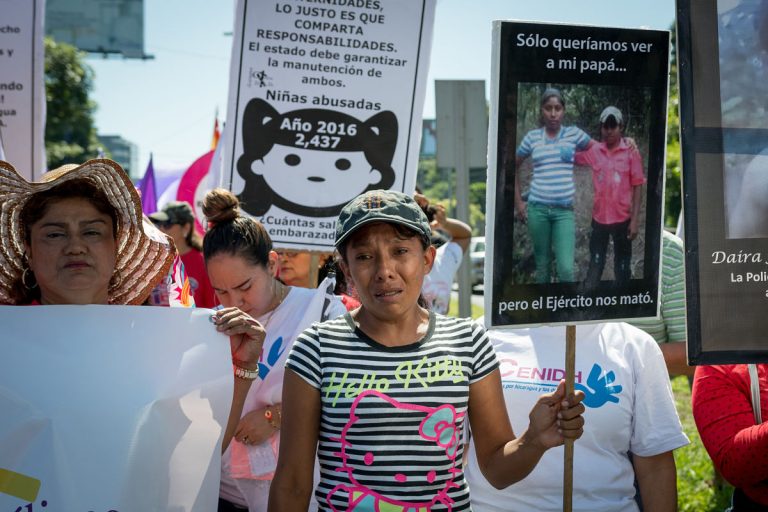2 de enero 2018

Children of Exile: The Births “Sowing Hope” in the Camp of Nicaraguan Farmers

PUBLICIDAD 1M
PUBLICIDAD 4D
PUBLICIDAD 5D
Beyond the laws, and the lawsuits, refusing to let family members bury their dead is inhumane behavior.

Versión policial no precisa los supuestos delitos de los niños masacrados ni menciona sus edades
I don’t know if it was out of scorn or morbidity, but Somoza used to publish the photos of dead Sandinista guerrillas on the front pages of the newspapers. These photos would show the bodies riddled with bullets, their faces nearly unrecognizable. For those of us who were their comrades in the struggle, their close friends, nearly family, the photos were devastating. Nevertheless, they helped us recognize the reality, the tragic fact of their death.
It was terrible to see the people one loved dead in this way, but it would have been a thousand times worse never to see them again at all.
In psychology, they speak of “closing the circle” of grief. That’s the purpose that burial serves. One accompanies the relative to the cemetery and leaves them in that place where all those who die go. Being there with them, participating in that ritual, is in a curious way a consolation because it’s a human experience that’s known and shared. Death is the great equalizer: in the face of it, there’s no important distinction of any kind. We resign ourselves to this truth of death, no matter how unreal it may seem to us. We say farewell to relatives, parents, husbands, wives, children, friends; we return them to the ground, and it’s something that’s definitive. We realize it: there’s no way back. They’ve gone back to the Earth. From Dust You Came, and To Dust You Shall Return.
But not being able to bury your dead children… To know that they’ve died, to know that there are photos of their dead bodies, to know with certainty that they’re dead but not to be able to see them or bury them, is not to allow the circle of that death to be closed; it’s blocking the family’s possibility of consolation, or of resignation in the face of sorrow.

Mary Frinwie Atanga, mother of the Cameroon migrant killed in Nicaragua. Photo: Wilmer Lopez /laprensa.com.ni
To deny family members the burial of their own is inhumane behavior. Beyond the laws and the lawsuits, any authority that acts in this way challenges precepts that hold a sacred character in the conscience of our species, whether or not they’re written down. The drama of Antigone from the Greek playwright Sophocles is an iconic literary piece that illustrates the terrible punishment suffered by King Creon for denying Antigone the right to bury her brother Polynices. The King ends up completely alone, since the heir to the throne commits suicide along with Antigone when she is condemned for trying to bury her brother, and then, grief-stricken by this, the King’s wife poisons herself.
Obviously, I broach this topic in the wake of the drama of two mothers: one a Nicaraguan from Cruz de Rio Grande, a municipality on Nicaragua’s South Caribbean Coast, and the other from Cameroon in Africa. Both are pleading for their sons’ bodies: both also demand that the authorities not continue evading their responsibility via accusations of criminal conduct for which there is no proof. To deny the family members the burial of a loved one, according to the elders and to many religions, is to invite Divine Rage.
There was talk of exhuming the bodies of Dona Elea’s sons, but according to her this hasn’t been done. In the case of Atanga Mary Frinwie, the mother from Cameroon, the cruelty of accusing her of human trafficking and holding her incommunicado in prison is a form of “punishment” for having dared to come in search of her son’s remains. This is cruel and unusual punishment. There hasn’t even been an adequate explanation of how he died by gunfire during his passage through our country towards the United States.
If there’s no divine rage, we have to believe in our own: in that of the fellow citizens or witnesses to those mothers who demand the bodies of their children, and justice.
Too much time has already passed. It’s of the utmost urgency that the government institutions assume responsibility and return those bodies to their family members. Let it not be that they end up pursued by those cadavers that have been withheld from their families.
Translated by Habana Times
Archivado como:
PUBLICIDAD 3M
Poeta y novelista nicaragüense. Ha publicado quince libros de poemas, ocho novelas, dos libros de ensayos, una memoria, y cuatro cuentos para niños. Su primera novela “La mujer habitada” (1988) ha sido traducida a más de catorce idiomas. Ganadora del Premio La Otra Orilla, 2010; Biblioteca Breve, de Seix Barral (España, 2008); Premio Casa de las Américas, en Cuba; Premio Internacional de Poesía Generación del ‘27, en España y Premio Anna Seghers de la Academia de Artes, de Alemania; Premio de Bellas Artes de Francia, 2014. En 2023 obtuvo el premio Reina Sofía de Poesía Iberoamericana, el más prestigioso para la poesía en español. Por sus posiciones críticas al Gobierno de Daniel Ortega y Rosario Murillo, fue despatriada y confiscada. Está exiliada en Madrid.
PUBLICIDAD 3D